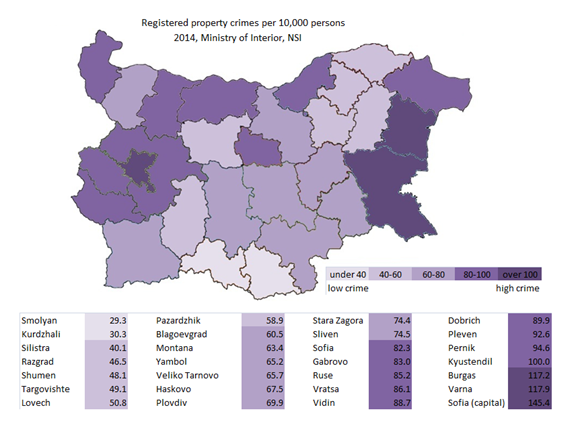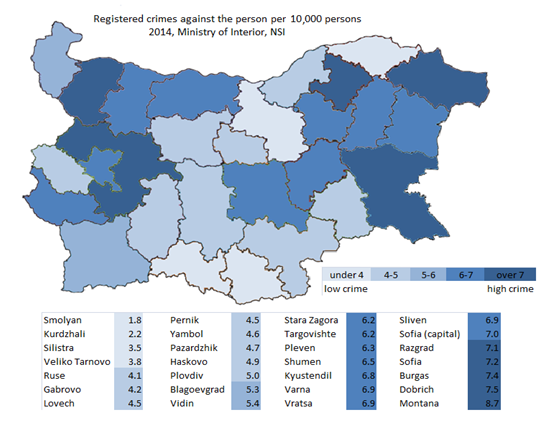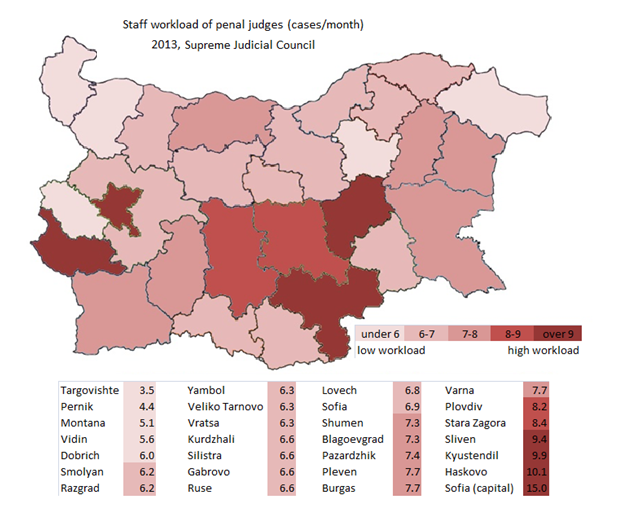Justice and Security in Bulgarian Regions
Zornitsa Slavova
The 2015 edition of “Regional profiles: Indicators of Development” which was presented in the beginning of November 2015, was the first to include indicators for security and justice on regional level.
We observe an interesting correlation between the indicators that describe crime and the work of courts on one hand, and economic development on the other. In economically developed districts there are more crimes against the person and property and the work of local justice systems is more problematic.
For instance, the most economically developed district – Sofia (cap.) – is also the one with worst indicators in the sphere of security and justice. The same goes for districts like, Blagoevgrad, Burgas and Varna. On the other side, districts such as Kurdzhali, Smolyan, Silistra and Lovech are characterized with low criminality and relatively effective local justice system, but poor economic development. As usual, there are exceptions –Gabrovo, while among the districts with best economic indicators also registers relatively low crime levels, moderate work load and relatively effective work of criminal judges at district courts. Yet the districts Kyustendil, Sliven and Montana illustrate combination between economy and performance of security and justice, both at poor level.
Crimes
In the last 15 years, registered crimes against the property on a national level declined from average 105.8 per 10,000 people in 2000 to 89 per 10,000 people in 2014. A slight increase is noticed in the crimes against person: from 4.5 per 10,000 people in 2000 to 5.9 per 10,000 people in 2014. In 2014, the districts Smolyan, Kardzhali and Silistra are characterized with the lowest crime levels in the entire country, as they demonstrate the lowest number of crimes against local population in both categories. Crime levels in Sofia, Varna and Burgas are nearly 4 times higher than this within districts Smolyan, Kardzhali and Silistra.
It should be mentioned that our analysis is based on registered crimes in only, Presumably in some districts the effectiveness of the police and/or the social trust in its work are lower, which may lead to artificially low levels of registered crimes. In the recently published issue of Index of Economic freedom, Bulgaria is distinguished as one of the countries where people have the lowest trust in the police, so this is probably a serious factor when interpreting the data.
Courts of justice
The data about the workload of judges in district courts also display a proportional relation with the state of regional economic development. In more developed districts such as Sofia (capital), Stara Zagora, Plovdiv, Varna and Burgas the workload of courts is higher. It is interesting to note that both in courts with high workload and in courts with low workload, effectiveness measured as the share of pending penal cases and the share of penal cases finished in a 3 month period is relatively low. From 2010 to 2013 the workload of judges from penal departments of district courts has decreased from 10.8 to 8.3 cases per month per judge. At the same time this does not reflect the duration of cases.
Although that measured against 2010 the workload of judges declines with over 30% in 2013, the share of cases completed in a 3 month period, decreases with barely 2.7 percentage points (from 91.1% to 88.4 %), and the share of pending cases increases with 0.7 pp (from 7.8 % to 8.5%). This is a sign for deepening ineffectiveness of law enforcement system on local level.




